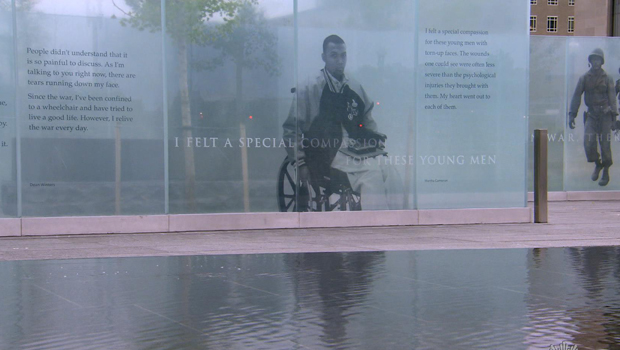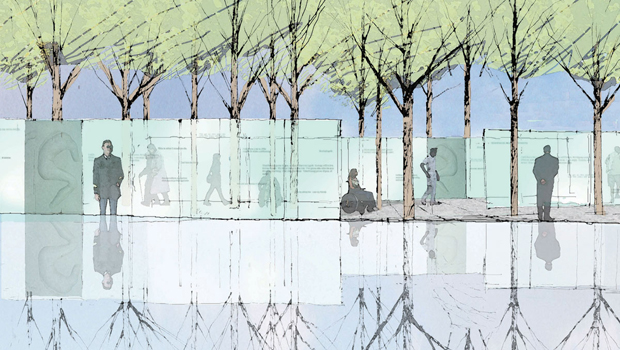Building a monument to wounded warriors
Our nation's wounded warriors need time to heal; and the rest of us need a place in which to reflect upon their sacrifice. Here's David Martin:
It's a thing of beauty designed to honor an ugly fact: the wounds of war. The name of Washington's newest memorial -- American Veterans Disabled for Life -- makes the point.
Project director Barry Owenby gave Martin an advance look at the memorial, which opens next Sunday. It's for disabled veterans of all wars, of whom an estimated three million are alive today.
"It doesn't end with the war; they live with it forever," Owenby said.
"They have a trauma of injury, a healing process, and then their rediscovery of purpose. So that's the story that we're trying to tell here."
It's the story of soldiers like Bob Dole, who came back from his World War II wounds to become a United States Senator and run for President: "It's faith that gives you the strength to endure," Dole wrote, "faith that won't allow you to give up, faith that manifests itself in a ferocious determination to take the next step -- the one that everyone else says is impossible."
They are also stories of disabled veterans you've never heard of.
Joe Bacani was shot through the pelvis by a sniper in Iraq in 2007. His story is on the monument's wall next to Bob Dole's.
Martin said to Bacani, "It doesn't matter if you're famous. It's what you've been through. So you probably earned it as much as Bob Dole did."
"Oh. That's humbling," he replied. "Because I, I've always seen myself as just, like, a normal average Joe."
A picture on the wall shows Bacani in a wheelchair, taken at his Purple Heart ceremony at Walter Reed. "Average Joe" Bacani is now a junior at Columbia University.
"I was never really ambitious," he said.
"Here you are getting an education at one of the top colleges in America!" said Martin.
"Yeah," he laughed. "So after I was wounded, I saw that as, like, a second chance, and I wanted to make the most out of it, especially for my friends' sacrifices. Like, I want to be the best I can be until I die."
The stories told here almost give the lie to George Washington's words that "Nothing could be a more melancholy and distressing sight than to behold those who have shed their blood or lost their limbs in the service of their country."
Harold Russell, who lost both hands in World War II, said, "It could be the end of the world for me, or it could be the beginning of a whole new life." He played a wounded veteran in the 1946 film, "The Best Years of Our Lives." His performance won him the Oscar for Best Supporting Actor.
Michael Naranjo ("Maybe I wouldn't be quite the same, but I felt I's make it back") lost his eyesight to a grenade in Vietnam, and went on to become a sculptor.
Martin asked Bacani, "What do you think you would have done if you hadn't been wounded? What would your life be like now?"
"It would probably be much more dull," he laughed. "It's actually like a blessing to be wounded in the name of our -- my country."
Plans for the memorial actually started before the wars in Iraq and Afghanistan began; that's how long it takes to navigate the federal bureaucracy.
The entire project cost $81 million, all of it from private donations. It was designed by architect Michael Vergason, and is located at the foot of Capitol Hill.
"When we went through interviews and discussions with disabled veterans, we heard time and time again they want to see the Capitol," said Vergason. "And we want the Capitol to see us, because what goes on in Capitol Hill has so much to do with the daily lives of veterans."
Park Ranger James Pierce walks with a brace on his left leg because of a suicide bomber in Afghanistan. He is now assigned to the memorial, in charge of volunteers who will keep it clean.
He says he doesn't know how he ended up with what would seem to be the perfect assignment: "I don't really know. It's kind of a blessing."
"What about it do you most appreciate?" asked Martin.
"With parks, you tend to take ownership of the land, and so for me to be able to sort of take ownership of this park," said Pierce.
There are 18 quotations etched in glass -- chosen by a panel which did not know the authors' names.
Vergason said, "They are both reflective and transparent, that you see yourself when you're reading these quotes. And these quotes are all first-person. They're first-person quotes of disabled veterans and caregivers that have a very personal and, I think, moving emotive value."
The photographs -- a daughter pushing her father in a wheelchair; the thousand-yard stare of a soldier in Vietnam -- need no words.
"I don't think I've ever seen a photograph that says so much with so little," said Vergason.
They are located in a grove of gingko trees, a species nearly wiped out during the Ice Age, but now making a comeback.
"They are in a sense survivors, reflective of the disabled veterans," said Vergason.
Survivors with an exquisite sense of timing: "They will turn a brilliant [color], almost on fire right around Veterans Day, and create a particularly spectacular event associated with the disabled veterans," said Vergason.
Twenty years from now, those gingkos will have reached their full size and provide a canopy over the glass panels. Twenty years from now, Joe Bacani will -- well, who knows? Except he has regained the use of his legs.
"Do you realize," said Martin, "that that photo of you is now going to be there forever?"
"I guess I realize that now, yeah," he laughed.
"Do you think that picture's a window into your soul?"
"I hope so," he replied, "and I hope people can see beyond the wheelchair -- that there's still a young man in there with many more years left to live, to make something out of himself."
For more info:
- American Veterans Disabled for Life Memorial, Washington, D.C.; Dedication ceremony Oct. 5, 2014; Monument location map
- Follow the Disabled Vet Memorial on Twitter (@AVDLM) and Facebook
- Wounded Warrior USA
- Gary Sinese Foundation


